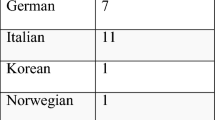Abstract
Children’s literature invariably reflects the views of adults. Likewise, what they think is desirable or not for children is also reflected in children’s literature translations. Yet adult assumptions, or ideology, may not always be in line with how children actually respond. This paper delves into this issue of ideology in terms of character name translation in Japanese picturebooks translated into Korean. While the majority of source text names are retained in English-to-Korean translations through transliteration, they are often changed into Korean names in Japanese-to-Korean translations. Interviews and an online questionnaire survey were conducted with Korean adult readers to find out how they respond to such differences, followed by an experiment with Korean children to see whether what adults think, revealed through the interviews and a survey, is consistent with how children actually respond. This paper hopes to shed light on how adult ideology affects children’s book translation, and how this can sometimes be misleading to children.



Similar content being viewed by others
Notes
The year 2009 is mentioned here because Korean age reckoning is different from the western system. Those born in 2009 all have the same age based on the Korean reckoning and thus are in one class.
Korean language title: 순이와 어린 동생. ST title: Asae and Her Little Sister, あさえとちいさいいもうと.
Korean language title: 우리 친구하자. ST title: とんことり.
DongaIlbo (Korean vernacular newspaper), May 2, 2009. http://news.donga.com/List/Series_70070000000015/3/70070000000015/20090502/8727383/1) [Accessed March 1, 2013].
A paired t test compares two samples in cases where each value in one sample has a natural partner in the other.
http://www.mogef.go.kr/korea/view/policy/policy02_05a.jsp?func=view&idx=691668. The statistics of 2014 are not yet available.
References
Alvstad, C. (2003). Publishing strategies of translated children’s literature in Argentina: A combined approach. Meta, 48(1–2), 121–125.
Alvstad, C. (2010). Children’s literature and translation. In Y. Gambier & L. Van Doorslaer (Eds.), Handbook of translation studies (pp. 22–27). Amsterdam, Philadelphia: John Benjamins.
Barthes, R. (1974). S/Z: An essay (R. Miller Trans.). New York: Hill and Wang.
Ben-Ari, N. (1992). Didactic and pedagogic tendencies in the norms dictating the translation of children’s literature: The case of postwar German-Hebrew translation. Poetics Today, 13(1), 221–230.
Cochran-Smith, M. (1984). The making of a reader. Norwood, NJ: Ablex.
Fernández López, M. (2000/2006). Translation studies in contemporary children’s literature: A comparison of intercultural ideological factors. In G. Lathey (Ed.) (2006), The translation of children’s literature: A reader (pp. 41–53). Clevedon: Multilingual Matters.
Fornalczyk, A. (2007). Anthroponym translation in children’s literature—early 20th and 21st centuries. Kalbotyra, 57(3), 93–101.
Franco Aixelá, J. (1996). Culture-specific items in translation. In R. Alvarez & M. del Carmen-Africa Vidal (Eds.), Translation, power, subversion (pp. 52–78). Clevedon: Multilingual Matters.
Hatim, B., & Mason, I. (1997). The translator as communicator. London: Routledge.
Hyun, E. J., & Kim, S. H. (2005). Understanding picture books. Paju: Sagyejeol.
Iser, W. (1978). The act of reading: A theory of aesthetic response. Baltimore: The Johns Hopkins University Press.
Iwabuchi, K. (2001). Uses of Japanese popular culture: Trans/nationalism and postcolonial desire for ‘Asia’ emergences. Journal for the Study of Media and Composite Cultures, 11(2), 199–222.
Kim, K. H. (1995). The interference of the Japanese language on Korean. The New Korean Language Life, 5(2), 3–26.
Kim, K. Y., Park, J. S., Choi, Y. M., Choi, Y. J., & Choi, J. S. (2006). Children’s literature and translation. Changi Children, 4(1), 6–41.
Klingberg, G. (1986). Children’s fiction in the hands of the translators. Malco: CWK Gleerup.
Lathey, G. (Ed.). (2006). The translation of children’s literature: A reader. Clevedon: Multilingual Matters.
Lee, K. J. (2011). The refinement campaign of Korean language and loan words from Japanese language. The Hallym Journal of Japanese Studies, 19, 187–214.
Morrow, L. (2012). Literacy development in the early years (7th ed.). MA: Pearson.
O’Sulllivan, E. (2005). Comparative children’s literature (Anthea Bell, trans.). London/New York: Routledge.
Pascua-Febles, I. (2006). Translating cultural references: The language of young people in literary texts. In J. Van Collie & W. P. Verschueren (Eds.), Children’s literature in translation: Challenges and strategies (pp. 111–122). Manchester: St. Jerome.
Pounds, G. (2011). ‘Foreignizing’ or ‘domesticating’ the ideology of parental control in translating stories for children: Insights from contrastive discourse analysis. Applied Linguistics, 32(2), 277–298.
Sipe, L. (2008). Storytime: Young children’s literary understanding in the classroom. New York: Teachers College Press.
Sung, S. E. (2013). Adult ideology reflected in translation of character names: Japanese-Korean picturebook translation compared with English-Korean picturebook translation. The Journal of Translation Studies, 14(2), 103–123.
Thompson-Wohlgemuth, G. (2003). Children’s literature and translation under the East German regime. Meta, 48(1–2), 241–249.
Van Coillie, J. (2006). Character names in translation: A functional approach. In J. Van Collie & W. P. Verschueren (Eds.), Children’s literature in translation: Challenges and strategies (pp. 123–139). Manchester: St. Jerome.
Van Collie, J., & Verschueren, W. P. (Eds.). (2006). Children’s literature in translation: Challenges and Strategies. Manchester: St. Jerome.
Yamazaki, A. (2002). Why change names? On the translation of children’s books. Children’s Literature in Education, 33(1), 53–62.
Acknowledgments
This research was funded by Hankuk University of Foreign Studies research fund of 2015, Korea.
Author information
Authors and Affiliations
Corresponding author
Rights and permissions
About this article
Cite this article
Sung, SE., Park, SJ. & Kim, K. Why not Japanese names? Reader response to character name translation. Neohelicon 43, 213–231 (2016). https://doi.org/10.1007/s11059-015-0311-z
Published:
Issue Date:
DOI: https://doi.org/10.1007/s11059-015-0311-z




